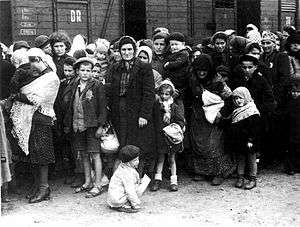Dieter Wisliceny
| Dieter Wisliceny | |
|---|---|
| Born | 13 January 1911 |
| Died | 4 May 1948 (aged 37) |
| Allegiance |
|
| Service/branch |
|
| Rank | Hauptsturmführer, SS |
| Unit | SS-Totenkopfverbände |
| Relations | Günther-Eberhardt Wisliceny (brother) |
SS-Hauptsturmführer Dieter Wisliceny (born 13 January 1911 in Regulowken now Możdżany, Giżycko County in East Prussia, now executed 4 May 1948 in Bratislava, now in the Republic of Slovakia), was a member of the Nazi SS, and a key executioner in the final phase of the Holocaust.
War crimes


Joining the Nazi Party in 1933 and enlisting in the SS in 1934, Wisliceny eventually rose to the rank of SS-Hauptsturmführer (Captain) in 1940.[1] During implementation of the Final Solution, his task was the ghettoization and liquidation of several important Jewish communities in Nazi-occupied Europe, including those of Greece, Hungary and Slovakia. Wisliceny also re-introduced the yellow star in occupied countries, the yellow star being used to distinguish Jews from non-Jews. He was involved in the deportation of the Hungarian Jews in 1944.
Wisliceny was an important witness at the Nuremberg trials, and his testimony would later prove important in the prosecution of Adolf Eichmann for war crimes in Israel in 1961. Wisliceny was extradited to Czechoslovakia, where he was tried and hanged for war crimes in 1948.
Eichmann told me that the words "final solution" meant the biological extermination of the Jewish race... I was so much impressed with this document which gave Eichmann authority to kill millions of people that I said at the time: "May God forbid that our enemies should ever do anything similar to the German people". He replied: "Don't be sentimental – this is a Führer order". I realized at that time that the order was a death warrant for millions of people and that the power to execute this order was in Eichmann's hands subject to approval of Heydrich and later Kaltenbrunner. The program of extermination was already under way, and continued until late 1944. — SS-Hauptsturmführer Dieter Wisliceny, International Military Tribunal at Nurnberg, 3 January 1946.[1]
Relatives
His younger brother was Obersturmbannführer Günther-Eberhardt Wisliceny (Lieutenant Colonel and recipient of Knights Cross of the Iron Cross). Gunther was also implicated in war crimes at Oradour-sur-Glane and other places.
References
- 1 2 Prof. Stuart Stein: "Affidavit of Dieter Wisliceny", from Nazi Conspiracy and Aggression, Volume VIII. USGPO, Washington, 1946, pages 606–619. Note: Dieter Wisliceny in his testimony given before the International Military Tribunal at Nurnberg, 3 January 1946, erroneously identifies the Auschwitz concentration camp as the concentration area Sosnowitz (which was one of its dozens of subcamps).
External links
- "Nuremberg testimony of Dieter Wisliceny". Nizkor Project. 2012. Retrieved 3 September 2016.